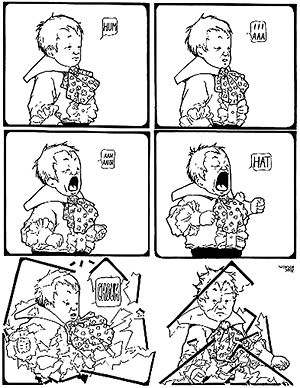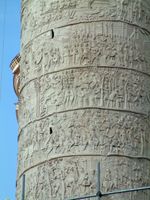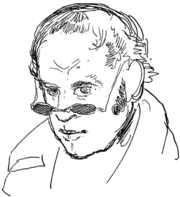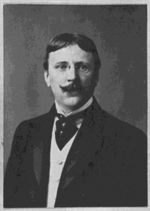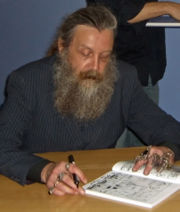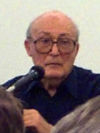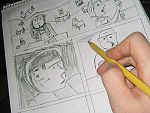Comics
2008/9 Schools Wikipedia Selection. Related subjects: Cartoons
Comics (via Latin, from the Greek "Κωμικ-ός", kōmikos, of or pertaining to "comedy", from kōmos "revel".) is a graphic medium in which words and images are utilised in order to convey a narrative. Comics can contain little or no words, and consist of one or more images, which may either illustrate or counterpoint the text to affect greater depth.
Although historically the form dealt with humorous subject matter, its scope has expanded to encompass the full range of literary genres.
Comics are typically seen as a low art, having established as a form in the late 19th and early 20th century. While preceding works are seen as sharing certain techniques, most notably the conveying of a narrative through imagery, most commentators are agreed that the form was established in the humorous cartoons and comic strips found in newspapers and magazines of the late 19th and early 20th century, and was fuelled by the boom in publishing technology. Early precursors include Trajan's Column and the Bayeaux Tapestry, as well as works by William Hogarth, Rodolphe Töpffer, Wilhelm Busch and George Cruikshank. Discussion of the form is even more recent, especially in the United States; although early criticism can be traced back to the 1920s, it is only in the latter half of the 20th century that serious examination of the form was begun. Definitions of the form are rather loose in their approach; some claim its printed format is crucial, some emphasize the interdependence of image and text, and others the sequential nature of the images.
Different conventions were developed around the globe, from the Manhua of China to the manga of Japan, the comic books of the United States and the anthology comic magazines featuring a variety of strips in Europe, initially established by the Ally Sloper comic paper. The comic strip established itself on the pages of newspapers through the success of Outcalt's Hogan's Alley and Yellow Kid, and was soon adopted elsewhere.
Although practitioners can eschew any formal constraints, they often use particular forms and conventions to convey narration and speech, or to evoke emotional or sensual responses. Devices such as speech balloons and boxes are used to indicate dialogue and impart establishing information, while panels, layout, gutters and zip ribbons can help indicate the flow of the story. Comics use of text, ambiguity, symbolism, design, iconography, literary technique, mixed media and stylistic elements of art help build a subtext of meanings. Similarly, the partnering of words and pictures can create a synergy of expression through the manner of their combination which can either enhance or subvert the meaning of each partner's individual contribution.
The most common forms of printed comics are comic strips (most commonly four panels long) in newspapers and magazines, and longer comic stories in comic books, graphic novels and comic albums. In the first two forms the comics are secondary material usually confined to the entertainment sections, while the latter consist either entirely or primarily of comics.
Early narratives in art
Comics as an art form established itself in the late 19th and early 20th century, alongside the similar forms of film and animation. The three forms share certain conventions, most noticeably the mixing of words and pictures, and all three owe parts of their conventions to the technological leaps made through the industrial revolution. Although the comics form was established and popularised in the pages of newspapers and magazines in the late 1890s, narrative illustration has existed for many centuries.
Rome's Trajan's Column, dedicated in 113 AD, is one of the earliest surviving examples of a narrative told through the use of sequential pictures, while Egyptian heiroglyphics, Greek friezes, mediaeval tapestries such as the Bayeaux Tapestry and illustrated manuscripts also demonstrate the use of images and words combined to convey a narrative. However, these works lack the ability to travel to the reader; it needed the invention of modern printing techniques to allow the form to capture a wide audience and become a mass medium.
The 15th–18th centuries and printing advances
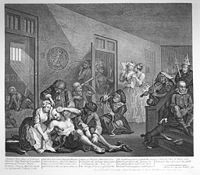
The invention of the printing press, allowing movable type, established a separation between images and words, the two requiring different methods in order to be reproduced. Early printed material concentrated on religious subjects, but through the 17th and 18th centuries they began to tackle aspects of political and social life, and also started to satirise and caricature. It was also during this period that the speech bubble was developed as a means of attributing dialogue.
William Hogarth is often identified in histories of the comics form. His work, A Rake's Progress, was composed of a number of canvases, each reproduced as a print, and the eight prints together created a narrative. As printing techniques developed, due to the technological advances of the industrial revolution, magazines and newspapers were established. These publications utilised illustrations as a means of commenting on political and social issues, such illustrations becoming known as cartoons in the 1840s. Soon, artists were experimenting with establishing a sequence of images to create a narrative.
While surviving works of these periods such as Francis Barlow's A True Narrative of the Horrid Hellish Popish Plot (c.1682) as well as The Punishments of Lemuel Gulliver and A Rake's Progress by William Hogarth, (1726) can be seen to establish a narrative over a number of images, it wasn't until the 19th century that the elements of such works began to crystallise into the comic strip.
The speech balloon also evolved during this period, from the medieval origins of the phylacter, a label, usually in the form of a scroll, which identified a character either through naming them or using a short text to explain their purpose. Artists such as George Cruikshank helped codify such phylacters as balloons rather than as scrolls, although at this time they were still referred to as labels. Although they were now used to represent dialogue, this dialogue was still used for identification purposes rather than to create a dialogue within the work, and artists soon discarded them in favour of running dialogue underneath the panels. The speech balloons weren't reintroduced to the form until Richard F. Outcault utilised them as a means of establishing dialogue within his works.
The 19th century: a form established
Rodolphe Töpffer, a Francophone Swiss artist, is seen as the key figure of the early part of the 19th century. Although speech balloons had fallen from favour during the middle part of the 19th century, Töpffer's sequentially illustrated stories, with the text compartmentalised below the images, were reprinted throughout Europe and the United States. The lack of copyright laws at this time allowed such pirated editions, and these translated versions created a market on both continents for similar works.
In 1845 Töpffer formalised his thoughts on the picture story in his Essay on Physiognomics: "To construct a picture-story does not mean you must set yourself up as a master craftsman, to draw out every potential from your material — often down to the dregs! It does not mean you just devise caricatures with a pencil naturally frivolous. Nor is it simply to dramatize a proverb or illustrate a pun. You must actually invent some kind of play, where the parts are arranged by plan and form a satisfactory whole. You do not merely pen a joke or put a refrain in couplets. You make a book: good or bad, sober or silly, crazy or sound in sense."
In 1843 the satirical drawings which had regularly been appearing in newspapers and magazines gained a name: cartoons. The British magazine Punch, launched in 1841, referred to its 'humorous pencilings' as cartoons in a satirical reference to the Parliament of the day, who were themselves organising an exhibition of cartoons, or preparatory drawings, at the time. This usage became common parlance, lasting into the present day. Similar magazines containing cartoons in continental Europe included Fliegende Blätter and Le Charivari, while in the U.S. Judge and Puck were popular.
1865 saw the publication of Max and Moritz by Wilhelm Busch by a German newspaper. Busch refined the conventions of sequential art, and his work was a key influence within the form, Rudolph Dirks inspired by the strip to create The Katzenjammer Kids in 1897.
It is around this time that Manhua, the Chinese form of comics, started to formalise, a process that lasted up until 1927. The introduction of lithographic printing methods derived from the West was a critical step in expanding the form within China during the early 20th century. Like Europe and the United States, satirical drawings were appearing in newspapers and periodicals, initially based on works from those countries. One of the first magazines of satirical cartoons was based on the United Kingdom's Punch, snappily re-branded as "The China Punch". The first piece drawn by a person of Chinese nationality was "The Situation in the Far East" from Tse Tsan-Tai, printed 1899 in Japan. By the 1920s a market was established for palm-sized picture books like Lianhuanhua.
In 1884, Ally Sloper's Half Holiday was published, a magazine whose selling point was a strip featuring the titular character, and widely regarded as the first comic strip magazine to feature a recurring character. In 1890 two more comic magazines debuted to the British public, Comic Cuts and Illustrated Chips, establishing the tradition of the British comic as an anthology periodical containing comic strips.
In the United States, R.F. Outcault's work in combining speech balloons and images on Hogan's Alley and The Yellow Kid has been credited as establishing the form and conventions of the comic strip. Although this view is being revised by current academics, who are uncovering many other works which combine speech bubbles and a multi image narrative, the popularity of Outcalt and the position of the strip in a newspaper is credited as being the driving force of the form.
The 20th century and the mass medium
The 1920s and 1930s saw further booms within the industry. In China a market was established for palm-sized picture books like Lianhuanhua, while the market for comic anthologies in Britain had turned to targeting children through juvenile humour, with The Dandy and The Beano launched. In Belgium, Hergé created the Tintin newspaper strip for a comic supplement; this was successfully collected in a bound album and created a market for further such works. The same period in the United States had seen newspaper strips expand their subject matter beyond humour, with action, adventure and mystery strips launched. The collection of such material also began, with The Funnies, a reprint collection of newspaper strips, published in tabloid size in 1929.
A market for such comic books soon followed, and by 1938 publishers were printing original material in the format. It was at this point that Action Comics#1 launched, with Superman as the cover feature. The popularity of the character swiftly enshrined the superhero as the defining genre of American comics, and although the genre fell out of favour in the 1950s, the 1960s saw it re-establish its domination of the form until the late 20th century.
In Japan, a country with a long tradition for illustration and whose language evolved from pictures, comics were hugely popular. Referred to as manga, the Japanese form was established after World War II by Osamu Tezuka, who expanded the page count of a work to number in the hundreds, and who developed a filmic style, heavily influenced by the Disney animations of the time. The Japanese market expanded its range to cover works in many genres, from juvenile fantasy through romance to adult fantasies. Japanese manga is typically published in large anthologies, containing several hundred pages, and the stories told have long been used as sources for adaptation into animated film. In Japan such films are referred to as anime, and many creators will work in both forms simultaneously, leading to an intrinsic linking of the two forms.
During the latter half of the 20th century comics have become a very popular item for collectors and from the 1970s American comics publishers have actively encouraged collecting and shifted a large portion of comics publishing and production to appeal directly to the collector's community.
Writing in 1972, Sir Ernst Gombrich certainly felt Töpffer to have evolved a new pictorial language, that of an abbreviated art style, which worked by allowing the audience to fill in gaps with their own imagination.
The modern double usage of the term comic, as an adjective describing a genre, and a noun designating an entire medium, has been criticised as confusing and misleading. In the 1960s and 1970s, underground cartoonists used the spelling comix to distinguish their work from mainstream newspaper strips and juvenile comic books; ironically, although their work was written for an adult audience, it was usually comedic in nature as well, so the "comic" label was still appropriate. The term graphic novel was popularised in the late 1970s, having been coined at least two decades previous, to distance the material from this confusion.
In the 1980s comics scholarship started to blossom in the U.S., and a resurgence in the popularity of comics was seen, with Alan Moore and Frank Miller producing notable superhero works and Bill Watterson's Calvin & Hobbes being syndicated.
In 2005 Robert Crumb's work was exhibited in galleries both sides of the Atlantic, and The Guardian newspaper devoted its tabloid supplement to a week long exploration of his work and idioms.
Forms
Comics have been presented within a wide number of publishing and typographical formats, from the very short panel cartoon to the more lengthy graphic novel. The cartoon, traditionally containing satirical or humorous content in the manner of those seen in The New Yorker or Private Eye, originate from the mid nineteenth century. This form of comics is still popular, although the last few years has seen a reduction in the number of editorial cartoonists employed in the US media. Although there is some dispute as to whether the cartoon constitutes a form of comics, a precursor or a related form, it has been argued that since the cartoon both combines words with image and constructs a narrative, it merits inclusion as a form of comics.
The comic strip is simply a sequence of cartoons which unite to tell a story within that sequence, and were originally known as strip cartoons. Originally the term comic strip was used to apply to any sequence of cartoons, no matter the venue of publication or length of the sequence, but now, mainly in the United States, the term refers to the strips published in newspapers. These strips are now typically humorous or satirical strips, such as Hägar the Horrible and Doonesbury, but have often been action themed, educational or even biographical. In the United States the term "comics" is sometimes used to describe the page of a newspaper upon which comic strips are found, with the term "comic" quickly adopting through popular usage to refer to the form rather than the content. Said pages are also referred to as the "funny pages", and comics are hence sometimes called "the funnies". In the United Kingdom, the term comic strip is still applied to the longer stories which appear in comics such as 2000 AD or The Beano.
Publication formats
Over time a number of formats have become closely associated with the form, from the comic book to the webcomic. The American comic book originated in the early part of the twentieth century, and grew from magazines which repackaged comic strips. Eventually, original material was commissioned, and the material developed from its humorous origins to encompass adventure stories, romance, war and superheroes, with the latter genre coming to dominate the comic book publishing industry in the latter parts of the twentieth century. Although referred to as comic books, these publications are actually more akin to magazines, having soft covers printed on glossy paper, with the interiors consisting of newsprint quality paper or higher grade. In Europe, magazines were always a venue for original material in the form, and such comic magazines or comic books soon grew into anthologies, in which a number of stories would be serialised. In continental Europe a market soon established itself to support collections of these strips. All of these publications are generally referred to as "comics" for short, with typical American and British comic books or magazines running 32 pages, including advertisements and letter column. (These are sometimes known as 36-page books, counting the covers.) European comic magazines have wildly varying page numbers, currently ranging mostly between 52 and 120 pages, while European comic albums traditionally had between 32 and 62 pages.
In the United States, when a publisher collects previously serialised stories, such a collection is commonly referred to as either a trade paperback or as a graphic novel. These are books, typically squarebound and published with a card cover, containing no adverts. They generally collect a single story, which has been broken into a number of chapters previously serialised in comic books, with the issues collectively known as a story arc. Such trade paperbacks can contain anywhere from four issues (for example, there is Kingdom Come by Mark Waid and Alex Ross) to as many as twenty ( The Death of Superman). In continental Europe, especially Belgium and France, such collections are usually somewhat larger in size and published with a hardback cover, a format established by the Tintin' series in the 1930s. These are referred to as comic albums, a term which in the United States refers to anthology books. The United Kingdom has no great tradition of such collections, although during the 1980s Titan publishing launched a line collecting stories previously published in 2000 AD.
The graphic novel format is similar to typical book publishing, with works being published in both hardback and paperback editions. The term has proved a difficult one to fully define, and refers not only to fiction but also factual works, and is also used to describe collections of previously serialised works as well as original material. Some publishers will distinguish between such material, using the term "original graphic novel" for work commissioned especially for the form.
Newspaper strips also get collected, both in Europe and in the United States, and these are sometimes also referred to as graphic novels. In the UK it is traditional for the children's comics market to release comic annuals, which are hardback books containing strips, as well as text stories and puzzles and games. In the United States, the comic annual was a summer publication, typically an extended comic book, with storylines often linked across a publisher's line of comics.
Webcomics, also known as online comics and web comics, are comics that are available on the Internet. Many webcomics are exclusively published online, while some are published in print but maintain a web archive for either commercial or artistic reasons. With the Internet's easy access to an audience, webcomics run the gamut from traditional comic strips to graphic novels and beyond.
Webcomics are similar to self-published print comics in that almost anyone can create their own webcomic and publish it on the Web. Currently, there are thousands of webcomics available online, with some achieving popular, critical, or commercial success. The Perry Bible Fellowship is syndicated in print, while Brian Fies' Mom's Cancer won the inaugural Eisner Award for digital comics in 2005 and was subsequently collected and published in hardback.
The comics form can also be utilized to convey information in mixed media. For example, strips designed for educative or informative purposes, notably the instructions upon an airplane's safety card. These strips are generally referred to as instructional comics. The comics form is also utilized in the film and animation industry, through storyboarding. Storyboards are illustrations displayed in sequence for the purpose of visualizing an animated or live-action film. A storyboard is essentially a large comic of the film or some section of the film produced beforehand to help the directors and cinematographers visualize the scenes and find potential problems before they occur. Often storyboards include arrows or instructions that indicate movement.
Like many other media, comics can also be self-published. One typical format for self-publishers and aspiring professionals is the minicomic, typically small, often photocopied and stapled or with a handmade binding. These are a common inexpensive way for those who want to make their own comics on a very small budget, with mostly informal means of distribution. A number of cartoonists have started this way and gone on to more traditional types of publishing, while other more established artists continue to produce minicomics on the side.
Artistic medium
Defining comics
Note: Although it takes the form of a plural noun, the common usage when referring to comics as a medium is to treat it as singular.
Scholars disagree on the definition of comics; some claim its printed format is crucial, some emphasize the interdependence of image and text, and others its sequential nature. The term as a reference to the medium has also been disputed.
In 1996, Will Eisner published Graphic Storytelling, in which he defined comics as "the printed arrangement of art and balloons in sequence, particularly in comic books." Eisner's earlier, more influential definition from 1985's Comics and Sequential Art described the technique and structure of comics as sequential art, "...the arrangement of pictures or images and words to narrate a story or dramatize an idea."
In Understanding Comics (1993) Scott McCloud defined sequential art and comics as: "juxtaposed pictorial and other images in deliberate sequence, intended to convey information and/or to produce an aesthetic response in the viewer"; this definition excludes single-panel illustrations such as The Far Side, The Family Circus, and most political cartoons from the category, classifying those as cartoons. By contrast, The Comics Journal's "100 Best Comics of the 20th Century", included the works of several single panel cartoonists and a caricaturist, and academic study of comics has included political cartoons .
R.C. Harvey, in his essay Comedy At The Juncture Of Word And Image, offered a competing definition in reference to McCloud's: "...comics consist of pictorial narratives or expositions in which words (often lettered into the picture area within speech balloons) usually contribute to the meaning of the pictures and vice versa." This, however, ignores the existence of wordless comics.
Most agree that animation, which creates the optical illusion of movement within a static physical frame, is a separate form, although ImageTexT, a peer-reviewed academic journal focusing on comics, accepts submissions relating to animation as well , and the third annual Conference on Comics at the University of Florida focused on comics and animation .
Art styles
While almost all comics art is in some sense abbreviated, and also while every artist who has produced comics work brings their own individual approach to bear, some broader art styles have been identified.
The basic styles have been identified as realistic and cartoony, with a huge middle ground for which R. Fiore has coined the phrase liberal. Fiore has also expressed distaste with the terms realistic and cartoony, preferring the terms literal and freestyle, respectively.
Scott McCloud has created The Big Triangle as a tool for thinking about comics art. He places the realistic representation in the bottom left corner, with iconic representation, or cartoony art, in the bottom right, and a third identifier, abstraction of image, at the apex of the triangle. This allows the placement and grouping of artists by triangulation.
- The cartoony style is one which utilises comic effects and a variation of line widths as a means of expression. Characters here tend to have rounded, simplified anatomy. Noted exponents of this style are Carl Barks, Will Eisner, Ray Mullikin and Jeff Smith.
- The realistic style, also referred to as the adventure style is the one developed for use within the adventure strips of the 1930s. They required a less cartoony look, focusing more on realistic anatomy and shapes, and used the illustrations found in pulp magazines as a basis. This style became the basis of the superhero comic book style, since Joe Shuster and Jerry Siegel originally worked Superman up for publication as an adventure strip.
Another style is the Ligne claire of Hergé and many others, which uses very simplified, uniform lines.
The language
As noted above, two distinct definitions have been used to define comics as an art form: the combination of both word and image; and the placement of images in sequential order. Both definitions are lacking, in that the first excludes any sequence of wordless images; and the second excludes single panel cartoons such as editorial cartoons. The purpose of comics is certainly that of narration, and so that must be an important factor in defining the art form.
Comics, as sequential art, emphasise the pictorial representation of a narrative. This means comics are not an illustrated version of standard literature, and while some critics argue that they are a hybrid form of art and literature, others contend comics are a new and separate art; an integrated whole, of words and images both, where the pictures do not just depict the story, but are part of the telling. In comics, creators transmit expression through arrangement and juxtaposition of either pictures alone, or word(s) and picture(s), to build a narrative.
The narration of a comic is set out through the layout of the images, and while there may be many people who work on one work, like films, there is one vision of the narrative which guides the work. The layout of images on a page can be utilised by artists to convey the passage of time, to build suspense or to highlight action.
Comic creation
Comics artists will generally sketch a drawing in pencil before going over the drawing again in ink, using either a dip pen or a brush. Artists will also make use of a lightbox when creating the final image in ink. Some artists, Brian Bolland being a notable example, are now using digital means to create artwork, with the published work being the first physical appearance of the artwork.
By many definitions (including McCloud's, above) the definition of comics extends to digital media such as webcomics and the mobile comic.
The nature of the comics work being created determines the number of people who work upon its creation, with successful comic strips and comic books being produced through a studio system, in which an artist will assemble a team of assistants to help in the creation of the work. However, works from independent companies, self-publishers or those of a more personal nature can be produced by as little as one creator.
Within the comic book industry of the United States, the studio system has come to be the main method of creation. Through its use by the industry, the roles have become heavily codified, and the managing of the studio has become the company's responsibility, with an editor discharging the management duties. The editor will assemble a number of creators and oversee the work to publication.
Any number of people can assist in the creation of a comic book in this way, from a plotter, a breakdown artist, a penciller, an inker, a scripter, a letterer, and a colorist, with some roles being performed by the same person.
In contrast, a comic strip tends to be the work of a sole creator, usually termed a cartoonist. However, it is not unusual for a cartoonist to employ the studio method, particularly when a strip become successful. Mort Walker is one such creator who employed a studio, while Bill Watterson was one such cartoonist who eschewed the studio method, preferring to create the strip himself. Gag, political and editorial cartoonists tend to work alone as well, although again it is not unheard of for a cartoonist to use assistants.
Tools
An artist will use a variety of pencils, paper, typically Bristol board, and a waterproof ink. When inking, an artist may choose to use a variety of brushes, dip pens, a fountain pen or a variety of technical pens or markers. Mechanical tints can be employed to add grey tone to an image. An artist might also choose to create his work in paints; either acrylics; gouache; poster paints; or watercolors. Colour can also be achieved through crayons, pastels or colored pencils.
Eraser, rulers, templates, set squares and a T-square assist in creating lines and shapes. A drawing board gives a good angled surface to work from, with lamps supplying necessary lighting. A light box allows an artist to trace his pencil work when inking, allowing for a looser finish. Knives and scalpels will fill a variety of tasks, including cutting board or scraping mistakes. A cutting mat will assist when cutting paper. Process white is a thick opaque white handy for covering mistakes, while adhesives and tapes are helpful in composition where an image may need to be assembled from different sources.
Computer generated comics
With the growth of computer processing power and ownership, there are now an increasing number of examples of comic books or strips where the art is made by using computers, either mixing it with hand drawings or replacing hand drawing completely. Dave McKean is one artist who combines both paper and the digital methods of composition for comics, while in 1998 Pete Nash pioneered the use of fully digitised 3D artwork on his Striker comic strip for The Sun. Computers are also now widely used for both lettering and coloring.
Comics in Higher Education
A growing number of universities around the world are recognizing the academic legitimacy of comics studies, leading to the presence of comics courses being offered at the college level. See "Links" and "Syllabi" at http://www.teachingcomics.org for lists of available courses.
